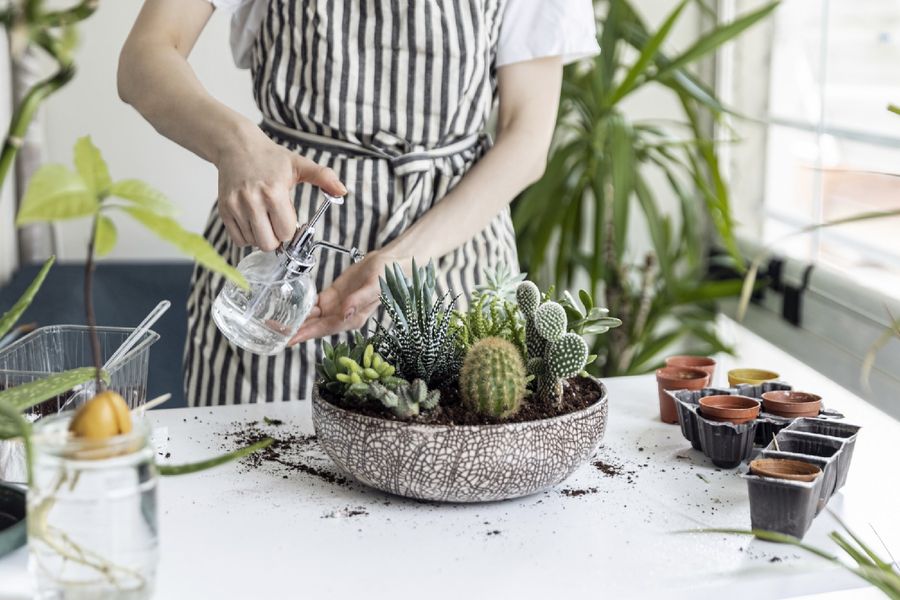Top 9 Succulent Arrangements You Should Know
Why Succulent Arrangements?
Succulent arrangements have taken the world of gardening by storm with their diverse range of shapes, colors, and sizes. They’re charming, require minimal care, and can adapt to various environments, making them perfect for novice gardeners and experienced enthusiasts alike. Yet, arranging succulents isn’t just about placing these plants together; it’s an art that requires knowledge, creativity, and an understanding of these unique plants. This article aims to provide a comprehensive guide on creating stunning succulent arrangements that will add life to any space.

Exploring the Different Types of Succulent Arrangements: Which One Suits You Best?
There’s no limit to the creativity and personal expression you can infuse into succulent arrangements. Each style speaks to a different aesthetic and has its own unique appeal. Here we dive deeper into the most popular types of succulent arrangements, their distinct characteristics, ease of creation, and maintenance levels, to help you determine which style suits you best.
Container Arrangement:
Popularity: Very Popular
Difficulty: Easy

Often the starting point for many succulent enthusiasts, container arrangements offer endless opportunities to express creativity. You can play around with various types of pots, from traditional terracotta to modern glazed ceramics, or even recycled items like vintage tin cans. The size, shape, and color of the container can significantly influence the overall aesthetic. You can make a solo feature of a large succulent or group them in odd numbers, remembering that odd numbers often look more natural and pleasing to the eye.
Keep in mind the growth habits of your selected succulents. For example, rosette-shaped succulents like Echeveria look particularly striking in the center, with trailing varieties such as String of Pearls along the edges.
Landscape arrangements:
Popularity: Popular
Difficulty: Medium to Hard (depending on the size of the landscape)

Landscape arrangements are like miniature ecosystems that represent a larger natural landscape. You could mimic a rocky desert, a lush oasis, or a serene beachscape in a tray or dish. Succulents of different shapes, sizes, and colors can be used to represent elements like hills, valleys, or rivers. Tiny figurines or miniature garden accessories can also be added for an extra layer of interest and narrative.
One crucial thing to remember while creating a landscape arrangement is to consider the sunlight requirements and watering needs of each plant, ensuring they are compatible.
Vertical Wall Arrangement:
Popularity: Growing in Popularity
Difficulty: Hard (depending on the local climate)

Vertical wall arrangements are a great way to bring succulents to eye level and make use of vertical space, especially in small apartments or urban dwellings. These are created using special wall planters or frames filled with a suitable growing medium. The choice of succulents for this arrangement type can be crucial, as they should ideally have shallow roots and similar light and water needs.
While visually stunning, they can be tricky to water and maintain, as the water tends to flow down with gravity, leaving the top plants dry while the bottom ones might get too wet.
Hanging Basket Arrangement:
Popularity: Popular
Difficulty: Easy to Medium

Hanging baskets offer a beautiful way to showcase succulents, especially those with trailing or cascading habits, like String of Bananas or Donkey’s Tail. These arrangements move gently with the breeze, adding a dynamic element to your indoor or outdoor space.
Ensure the hanging basket has adequate drainage to prevent water-logging. Also, consider the weight of the arrangement once fully watered to choose a secure hanging method.
Dish Garden:
Popularity: Popular
Difficulty: Easy

Dish gardens are typically shallow dishes or trays filled with succulents. This type of arrangement offers a broader surface area to work with and can be a great way to experiment with different plant groupings. You can create miniature hills with mounds of soil, use small rocks to suggest a dry river bed, or a larger rock to look like a natural boulder in a landscape.
Fairy Garden:
Popularity: Popular among DIY enthusiasts
Difficulty: Medium

Creating a fairy garden can be a fun and whimsical project to undertake, especially with children. Along with succulents, you can add miniature fairy houses, tiny garden tools, or small figurines. You could even include a small water feature or a fairy-sized pathway made from pebbles. The only limit here is your imagination!
Just remember, these gardens can get intricate, so they require careful watering to avoid damaging the accessories with water or displacing them.
Wreath Arrangement:
Popularity: Popular during holidays
Difficulty: Medium

Creating a wreath arrangement with succulents can result in a beautiful piece of living art to hang on your wall or door. To make one, you’ll need a wreath frame, sphagnum moss, and fishing line or floral wire to secure the succulents. You can choose a single variety for a uniform look or multiple types for a more diverse aesthetic.
Keep in mind that maintaining a succulent wreath can be a bit challenging as the wreath is often hung vertically, which affects how the water drains when watering.
Topiary Arrangement:
Popularity: Less Common
Difficulty: Hard

Topiary arrangements involve a lot of patience and time but can result in a truly eye-catching and unique piece of living sculpture. You would need a wire frame in the shape you desire (like a heart, sphere, or animal), sphagnum moss, and a selection of small, compact succulents. The key here is to keep the frame evenly covered and filled out as the succulents grow, which may require regular pruning and adjustments.
Terrarium Arrangement:
Popularity: Less Common due to difficulty
Difficulty: Hard

Terrariums are small, enclosed environments for succulents and are visually striking due to the clear glass containers often used. They allow you to create miniature indoor gardens that can sit on a desk or hang from the ceiling.
However, because they are enclosed, there can be challenges with ventilation and moisture control. It’s important to select succulents that thrive in humid conditions and to monitor and adjust the environment as needed.
Essential Tips for Successful Succulent Arrangement: What Do You Need to Keep in Mind?
Creating a beautiful succulent arrangement is an art, but it also requires an understanding of these unique plants’ needs to ensure they thrive. Whether you’re a beginner or an experienced succulent enthusiast, these essential tips will guide you to create an eye-catching and healthy arrangement.
- Choose Your Container Wisely: The first step in creating a succulent arrangement is choosing the right container. While aesthetics are essential, the container’s practicality is crucial for your succulents’ health. The container should have a drainage hole to prevent waterlogging and root rot. If your chosen container doesn’t have one, you can drill a hole yourself or use a layer of pebbles at the bottom to facilitate drainage. Remember, creativity is key in succulent arrangements, and you can repurpose different items, like vintage teapots, ceramic bowls, or even old boots!
- Use the Right Soil Mix: Succulents prefer well-draining soil that doesn’t retain too much water. Regular potting soil is often too dense for succulents, leading to waterlogging and root rot. Choose a succulent or cactus mix or make your own by combining regular potting soil with coarse sand and perlite in a 1:1:1 ratio. This mix will provide excellent drainage, ensuring your succulents are healthy.
- Consider Sunlight and Water Requirements: When choosing succulents for your arrangement, keep their sunlight and water requirements in mind. Succulents that prefer the same amount of light and water should be grouped together for a successful arrangement. For example, some succulents thrive in full sunlight, while others prefer indirect light. Similarly, some succulents require more frequent watering than others. Considering these factors will ensure your succulents thrive together in their new home.
- Think About Color, Texture, and Size: For a visually appealing arrangement, consider the color, texture, and size of your succulents. Mix and match different succulents to create contrast and visual interest. You could pair rosette-shaped succulents with tall, columnar types or mix succulents with different leaf textures. Don’t forget about colors – succulents come in a wide range of hues, from deep greens to vibrant purples, blues, and even reds!
- Know How to Care for Your Arrangement: Caring for your succulent arrangement is just as important as creating it. Remember to water your succulents only when the soil is completely dry to prevent overwatering, a common mistake among succulent growers. Provide enough sunlight depending on your succulents’ needs and protect them from extreme weather conditions. With the right care, your succulent arrangement will continue to thrive and bring joy for years to come.
- Don’t Be Afraid to Experiment: Finally, don’t be afraid to experiment and let your creativity shine. There are no strict rules when it comes to succulent arrangements. If one arrangement doesn’t work out, you can always replant your succulents and try again. The joy of succulent gardening lies in the creative process and the endless possibilities these resilient plants offer.
Now that we’ve discussed the essential tips for creating a succulent arrangement, let’s delve into how to care for your succulent arrangement and address common challenges that you may face.
Common Challenges and How to Overcome Them: What Should You Do When Things Don't Go as Planned?
Even the most experienced succulent gardeners face challenges when it comes to succulent arrangements. Don’t be disheartened if you come across some obstacles along the way. Remember, gardening is a learning process, and each challenge gives you a chance to learn more about your plants. Here are some common challenges in succulent arrangements and tips on how to overcome them:
- Overwatering and Underwatering: Overwatering is the most common cause of succulent death. Succulents store water in their leaves, stems, and roots, and they generally prefer less water compared to other plants. If you notice your succulents’ leaves becoming translucent, mushy, and falling off easily, it’s a sign of overwatering. To avoid this, water your succulents only when the soil is completely dry. Remember, it’s better to underwater than overwater. On the other hand, underwatering can also be a problem, although it’s less common. Signs of underwatering include shriveled, wrinkled leaves, and slow growth. If your succulents show these signs, gradually increase the watering frequency.
- Lack of Sunlight: Succulents love sunlight, but not all can tolerate direct sunlight all day. Some succulents can get sunburned, showing signs like bleached, brown, or black spots. If you notice these signs, move your arrangement to a spot with less direct sunlight. On the other hand, if your succulents aren’t getting enough sunlight, they may become etiolated or ‘stretched out’ as they try to reach for more light. In this case, gradually move your arrangement to a brighter spot.
- Insects and Pests: Succulents can attract pests like mealybugs, aphids, and spider mites. If left unchecked, these pests can damage or even kill your plants. Check your succulents regularly for signs of pests, such as small, cottony spots for mealybugs or tiny webbing for spider mites. If you spot any pests, remove them using a cotton swab dipped in rubbing alcohol, or treat the plant with an appropriate pesticide.
- Poor Drainage: As mentioned earlier, succulents prefer well-draining soil and pots with drainage holes. If the soil stays waterlogged for too long, it can lead to root rot, a fatal condition for succulents. Ensure your pot has a drainage hole and use a well-draining soil mix to prevent this issue.
- Plant Compatibility: When creating an arrangement, it’s crucial to pair succulents with similar light and water requirements. If some succulents in the arrangement are thriving while others seem to struggle, it might be due to mismatched plant needs.
Remember, challenges are part of the gardening journey. Don’t be disheartened if you face a few obstacles. Instead, view them as opportunities to learn and improve. Now, let’s move on to the last section of our guide – exploring creative succulent arrangement ideas.










































































